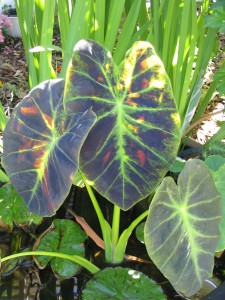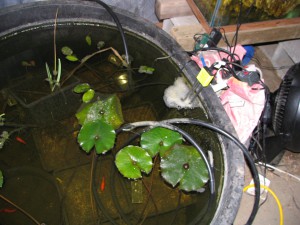
I’ve been interested in growing plants in water for nearly as long as I’ve been interested in growing plants–that is, most of my life. Fifteen years ago I was experimenting with various aquatic plant set ups and started raising more and more fish to eat the mosquitoes and provide a healthier aquatic ecosystem. It just seemed natural to extend the plumbing to the wicking mat benches and into some of the experimental hydroponic setups I had played with. This allowed the terrestrial plants to benefit from the nutrient rich water, and provided more filtration and stability to the system overall.
Ten years ago, while I was laying the foundations of what would become Mid Columbia Gardens, I stumbled upon the closed loop systems for raising fish and plants that people were beginning to share on the internet. The name they were giving it was aquaponics, from aquaculture, the raising of fish and aquatic animals, and hydroponics, the raising of plants in water. I had reservations at the time about the ability of the fish and their food to provide the entire profile of nutrients that the plants required, as well as the ability of the plants to completely eliminate all excess wastes that might build up in the water.
In practice, it turns out that most people are able to supplement and rebalance the water to keep both the plants and fish happy without too much trouble. It is also common for large systems to export some of the solid waste and turn over small percentages of their water while still retaining primarily “closed loop” recirculating systems.

These concerns, and sheer lack of time and funds, kept me from looking too deeply into it until someone showed me pictures of Growing Power and their large scale, successful aquaponics operation. Among other initiatives, they run a large scale fish and plant production greenhouse with unskilled volunteers and a home grown infrastructure. I can’t do them justice; go check them out at the link above. Seriously, I’ll wait.
By this time I had cycled hundreds of self-sustaining aquatic systems of all sizes, from 5 gallons to thousands, in saltwater, fresh water, and brackish water. I was keeping seahorses and koi, snails and shrimp, frogs and crabs. I also had a good-size non-production greenhouse that had held water systems before the glazing was even on. I was running radiant heating from the greenhouse ponds through both the air and the soil and using that water as the sole source of watering for all of the plants in there. The time seemed right to step up to a full aquaponic system.

